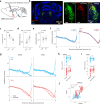Phase synchrony between prefrontal noradrenergic and cholinergic signals indexes inhibitory control
- PMID: 40770025
- PMCID: PMC12328735
- DOI: 10.1038/s41467-025-62317-5
Phase synchrony between prefrontal noradrenergic and cholinergic signals indexes inhibitory control
Abstract
This study investigates how norepinephrine (NE) and acetylcholine (ACh) in the prefrontal cortex (PFC) modulate inhibitory control, a critical executive function. Using fluorescent sensors, we tracked prefrontal NE/ACh dynamics in mice during inhibitory control tasks and found strong NE-ACh coherence at 0.4-0.8 Hz. Inhibiting locus coeruleus (LC) neurons projecting to the basal forebrain (BF) induced greater impairments in inhibitory control than targeting those projecting to the PFC, despite partial overlap. This inhibition disrupted NE-ACh phase synchrony between successful and failed trials, indicating its importance. Conversely, silencing cholinergic neurons projecting to the LC did not affect task performance or phase synchrony. Neuropixels recordings revealed that disrupting LC-BF projections impaired PFC neuronal encoding and altered population firing patterns linked to inhibitory control. These findings suggest that the LC and cholinergic systems jointly modulate inhibitory control by influencing NE-ACh synchrony and its effect on PFC activity, underscoring their role in cognitive control.
© 2025. The Author(s).
Conflict of interest statement
Competing interests: Q.W. is the co-founder of Sharper Sense. The remaining authors declare no competing interests.
Figures








Update of
-
Phase synchrony between prefrontal noradrenergic and cholinergic signals indexes inhibitory control.bioRxiv [Preprint]. 2025 Jan 27:2024.05.17.594562. doi: 10.1101/2024.05.17.594562. bioRxiv. 2025. Update in: Nat Commun. 2025 Aug 6;16(1):7260. doi: 10.1038/s41467-025-62317-5. PMID: 38798371 Free PMC article. Updated. Preprint.
References
-
- Dalley, J. W. & Robbins, T. W. Fractionating impulsivity: neuropsychiatric implications. Nat. Rev. Neurosci.18, 158–171 (2017). - PubMed
-
- Terra, H. et al. Prefrontal cortical projection neurons targeting dorsomedial striatum control behavioral inhibition. Curr. Biol.30, 4188–4200.e4185 (2020). - PubMed
-
- Miller, E. K. & Cohen, J. D. An integrative theory of prefrontal cortex function. Annu. Rev. Neurosci.24, 167–202 (2001). - PubMed
MeSH terms
Substances
Grants and funding
- R01NS119813/U.S. Department of Health & Human Services | NIH | National Institute of Neurological Disorders and Stroke (NINDS)
- FA9550-22-1-0337/United States Department of Defense | United States Air Force | AFMC | Air Force Office of Scientific Research (AF Office of Scientific Research)
- R01 NS119813/NS/NINDS NIH HHS/United States
- R01MH112267/U.S. Department of Health & Human Services | NIH | National Institute of Mental Health (NIMH)
- R01 MH112267/MH/NIMH NIH HHS/United States
LinkOut - more resources
Full Text Sources
Molecular Biology Databases
Miscellaneous

